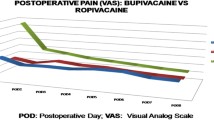Abstract
The opioid epidemic has proven to be a public health crisis over the past two decades and efforts to decrease opioid exposure are sorely needed. Our objective was to determine whether pudendal nerve block utilization in the immediate pre-operative setting decreases intra-operative opioid analgesic requirements in veteran patients undergoing a primary inflatable penile prosthesis implantation. We performed a retrospective cohort analysis of all patients undergoing penile prosthesis implantation between January 2017 and July 2020 at the Charlie Norwood Veterans Affairs Medical Center in Augusta, GA. Univariable and multivariable gamma regression analyses were performed to evaluate the association between pudendal nerve block utilization and intra-operative opioid analgesic requirements. The study cohort consisted of 110 patients, 35 (31.8%) of whom underwent a pudendal nerve block. Median intra-operative opioid analgesic requirements were significantly lower in the pudendal nerve block group (16.3 versus 25.8 morphine milliequivalents, p = 0.037). Receipt of the nerve block was associated with significantly lower intra-operative opioid analgesic requirements on multivariable (coefficient 0.84, p = 0.038) regression analysis. There was no significant difference in post-operative opioid analgesic requirements (p = 0.18). In conclusion, pre-operative pudendal nerve blocks decrease intra-operative opioid analgesic requirements in veteran patients undergoing a primary inflatable penile prosthesis implantation.

Similar content being viewed by others
References
Lyden J, Binswanger IA. The United States opioid epidemic. Semin Perinatol. 2019;43:123–31.
Gounder, C. Who is responsible for the pain-pill epidemic? https://www.newyorker.com/business/currency/who-is-responsible-forthe-pain-pill-epidemic. Published November 8, 2013. Accessed November 27, 2020.
US Department of Health and Human Services. Addressing prescription drug abuse in the United States: current activities and future opportunities. https://www.cdc.gov/drugoverdose/pdf/hhs_prescription_drug_abuse_report_09.2013.pdf. Published September 2013. Accessed November 27, 2020.
Compton WM, Jones CM, Baldwin GT. Relationship between nonmedical prescription-opioid use and heroin use. N Engl J Med. 2016;374:154–63.
Gallagher RM. Advancing the pain agenda in the veteran population. Anesthesiol Clin. 2016;34:357–78.
Gellad WF, Good CB, Shulkin DJ. Addressing the Opioid Epidemic in the United States: Lessons from the Department of Veterans Affairs. JAMA Intern Med. 2017;177:611–2.
Thiels CA, Anderson SS, Ubl DS, Hanson KT, Bergquist WJ, Gray RJ, et al. Wide Variation and Overprescription of Opioids after Elective Surgery. Ann Surg. 2017;266:564–73.
Lucas J, Gross M, Yafi F, DeLay K, Christianson S, El-Khatib FM, et al. A Multi-institutional Assessment of Multimodal Analgesia in Penile Implant Recipients Demonstrates Dramatic Reduction in Pain Scores and Narcotic Usage. J Sex Med. 2020;17:518–25.
Raynor MC, Smith A, Vyas SN, Selph JP, Carson CC 3rd. Dorsal penile nerve block prior to inflatable penile prosthesis placement: a randomized, placebo-controlled trial. J Sex Med. 2012;9:2975–9.
Xie D, Nicholson M, Azaiza M, Gheiler V, Lopez I, Nehrenz GM, et al. Effect of operative local anesthesia on postoperative pain outcomes of inflatable penile prosthesis: prospective comparison of two medications. Int J Impot Res. 2018;30:93–96.
Ghanavatian S, Derian A. Pudendal Nerve Block. [Updated 2020 Jul 31]. In: StatPearls [Internet]. Treasure Island (FL): StatPearls Publishing; 2021 Jan-. https://www.ncbi.nlm.nih.gov/books/NBK551518/
Rojo EG, Gomez BG, Manfredi C, Isa MA, Polo JM, Miguel MC, et al. Efficacy and safety of dorsal penile nerve block before collagenase of clostridium histolyticum injections in peyronie’s disease patients: results from a prospective pilot study. Andrologia. 2020;52:e13740.
Hsu G, Hsieh C, Wen H, Chen SC, Chen YC, Liu LJ, et al. Outpatient penile implantation with the patient under a novel method of crural block. Int J Androl. 2004;27:147–51.
Hsu G, Hsieh C, Chen H, Ling PY, Wen HS, Liu LJ, et al. The advancement of pure local anesthesia for penile surgeries: can an outpatient basis be sustainable? J Androl. 2007;28:200–5.
Cotta BH, Welliver C, Brahmamdam A, Bednarchik CL, Dynda D, Kohler TS. Long-acting liposomal bupivacaine decreases inpatient narcotic requirements in men undergoing penile prosthesis implantation. Turk J Urol. 2016;42:230–4.
Hsu G, Zaid UX, Hsieh C, Huang S. Acupuncture assisted local anesthesia for penile surgeries. Transl Androl Urol. 2013;2:291–300.
Author information
Authors and Affiliations
Contributions
Conception and design: RKS, MKT, ZK, SAK. Acquisition of data: NST, JO, MDO, KLF. Analysis and interpretation of data: RKS, NST, JO, MDO, KLF, MKT, ZK, SAK. Drafting paper: RKS. Critical revision of paper for important intellectual content: NST, JO, MDO, KLF, MKT, ZK, SAK. Final approval of paper: RKS, NST, JO, MDO, KLF, MKT, ZK, SAK.
Corresponding author
Ethics declarations
Competing interests
The authors declare no competing interests.
Additional information
Publisher’s note Springer Nature remains neutral with regard to jurisdictional claims in published maps and institutional affiliations.
Supplementary information
Rights and permissions
About this article
Cite this article
Sayyid, R.K., Taylor, N.S., Owens-Walton, J. et al. Pudendal nerve block prior to inflatable penile prosthesis implantation: decreased intra-operative narcotic requirements. Int J Impot Res 35, 1–5 (2023). https://doi.org/10.1038/s41443-021-00495-8
Received:
Revised:
Accepted:
Published:
Issue Date:
DOI: https://doi.org/10.1038/s41443-021-00495-8
- Springer Nature Limited
This article is cited by
-
Penoscrotal inflatable penile prosthesis recipients often fully recover from pain at two weeks following placement
International Journal of Impotence Research (2024)
-
Commentary on: “Oxycodone prescription after inflatable penile prosthesis has risks of persistent use: a TriNetX Analysis”
International Journal of Impotence Research (2023)




